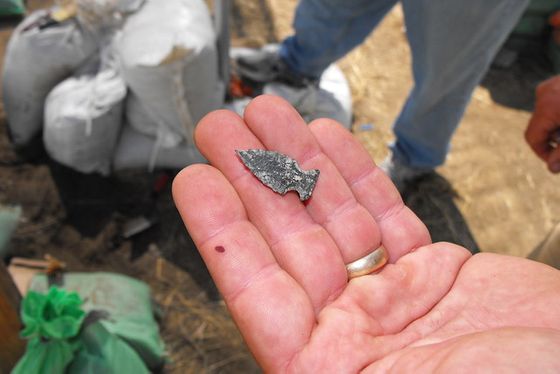From the newly discovered stone tool, the theory that 'the first American may have come from Japan' suddenly emerged

According to the established theory so far, the first humans who came to the North American continent were people from the era of
Late Upper Paleolithic occupation at Cooper's Ferry, Idaho, USA, ~ 16,000 years ago | Science
https://science.sciencemag.org/content/365/6456/891
Stone tools suggest the first Americans came from Japan | Ars Technica
https://arstechnica.com/science/2019/08/16000-year-old-site-in-idaho-indicates-people-sailed-around-the-ice-sheet/
15,000-year-old Idaho archaeology site now among America's oldest
https://www.nationalgeographic.com/culture/2019/08/coopers-landing-idaho-site-americas-oldest/
First Americans arrived at least 16,000 years ago, and probably by boat | NOVA | PBS | NOVA | PBS
https://www.pbs.org/wgbh/nova/article/coopers-ferry-first-americans/
In the 1930s, several archaeological sites were discovered in Clovis , New Mexico, USA, which are considered to be from the Late Ice Age. In addition, the stone culture that flourished in this era was found in the subsequent survey, as many stone tools such as pointed instruments were excavated from the formation of the Clovis Formation about 13,000 years ago distributed throughout the North American continent. Is called Clovis culture .

by
Many of these discoveries have led to the prominence of the “Clovis First” theory that the people of the Clovis culture were the first humans to flourish in America. In this theory, the origin of American indigenous people explains that “human beings in Africa came to the United States through the Bering Strait where ice melted in the late glacial period”.
However, since then, traces of mankind have been found in the formations older than the Clovis Formation, and the “Clovis First” hypothesis has been questioned. Meanwhile, Lauren Davis, an anthropologist at Oregon State University, unearthed relics such as stone tools, charcoal, and animal bones from the Coopers Ferry Ruins in western Idaho. According to radiocarbon dating , many of these relics are about 15,000 to 16,000 years old.
The following figure is a map simulating the area around Coopers Ferry 16,000 years ago, and the part shown in light blue in the northern part of the map is an ice sheet .

“This is really exciting. Probably part of the oldest human race in North America,” commented Aria Lesnek, a geology researcher at the University of New Hampshire. In addition, from the age of the relics, he says, “The idea that the first human race in the Americas came over land that is not covered by ice is basically excluded.”
This is because the Bering Strait 16,000 years ago was almost closed by ice, and it was thought that humans could not move. For this reason, Mr. Lesnek
The red arrow in the following figure is the “ice-free land route” that has long been the norm, and the orange arrow is the recently proposed “Pacific coastal route”. Mr. Lesnek believes that the ice was melting about 17,000 years ago on the Pacific coast, so the first humans who came to the United States would have taken this route by boat.

Davis et al. Also discovered that the stoneware discovered this time is very similar to the stoneware of the same age found in Japan. The following figure compares the stoneware found at Coopers Ferry site with the illustration of stoneware excavated from the

University of Washington archaeologist Donald Grayson said, “Even if there are similarities in ancient relics, they should not be considered relevant unless they are quite complex,” Coopers He showed a cautious attitude to the indication that the stone tools of the ferry ruins and the Shirataki ruins were similar.
On the other hand, Todd Brye, an archaeologist at San Diego State University, “It ’s a very interesting connection. Speaking and commenting that future research may provide new insights.
Related Posts:
in Science, Posted by log1l_ks







